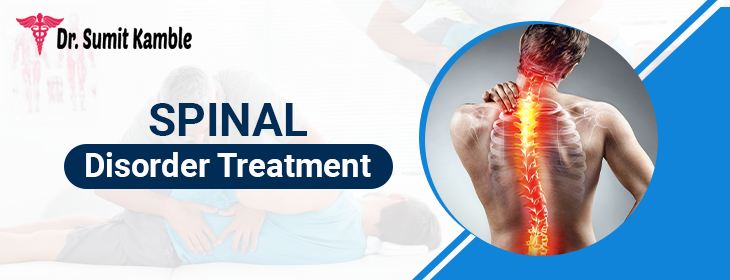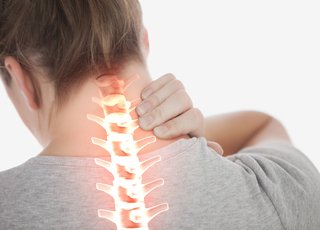What is Spinal Disorder?

Spinal Disorder is the narrowing of the gaps within your spine that can cause pressure on
the nerves that run through it. It most commonly affects the lower back and neck. Some
patients with spinal disorders may not experience any symptoms. Others could feel
discomfort, tingling, numbness, or muscular weakness. Symptoms might go wrong with
time.
The spinal disorder is most typically caused by osteoarthritis wear-and-tear alterations in
the spine. In extreme cases of spinal this, doctors may advise surgery to provide more room
for the spinal cord or nerves.
What are the types of Spinal Disorder?
The types of spinal disorders are categorised based on where the problem arises in the spine.
It is possible to have many types. In general, there are two types:-

The narrowing happens in the region of the spine in your neck
with this disease.

The narrowing of the spine in your lower back develops in this
condition. It is the most diffused kind of spinal disorder.
What are the symptoms of spinal disorders?
Some people have proof of spinal disorder on the MRI and CT scan but many do not have any
type of symptoms. But they can occur at any time. Symptoms may depend differently on the
location of the disorder and where nerves are affected.
In the neck (cervical spine):
- You may feel numbness or tingling in the palm, arm,
foot, or leg.
- Your arm, foot, or leg may feel weakness
- You may feel problems while walking and balancing
- You may feel pain in the neck
- In many cases, you may feel bladder
dysfunction(urinary urgency)
In the lower back (lumbar spine):
- Numbness or tingling in a foot or leg in the lower
back (lumbar spine)
- Foot or leg weakness
- Pain or cramping in one or both legs when standing or
walking for lengthy periods, which normally subsides when you lean forward or sit
- Backache
Treatment of Spinal Disorder
1. Medications
Doctors may prescribe to you:-
• Pain Relievers
Ibuprofen (Advil, Motrin IB, and others), naproxen (Aleve, and others), and acetaminophen
(Tylenol, and others) may be used to relieve the pain of spinal disorder. They are usually only
suggested for a limited period because there is minimal evidence of long-term benefit.
• Antidepressants
Tricyclic antidepressants, such as amitriptyline, might be used at night to assist relieve
chronic pain.
• Anti-seizure Medication
Some seizure medications, such as gabapentin (Neurontin) and pregabalin (Lyrica), are used to
reduce pain caused by injured nerves.
• Opioids
Codeine-related medicines like oxycodone (Oxycontin, Roxicodone) and hydrocodone (Norco,
Vicodin) may be beneficial for short-term pain relief. Opioids should likewise be approached
with caution for long-term therapy. They do, however, involve the danger of major adverse
effects, including habit formation.
2. Physical Therapy
To alleviate discomfort, patients with spinal stenosis often become less active. However, this
might result in muscular weakening, which can lead to even greater discomfort. A physical
therapist can teach you the following activities that may be beneficial to:
» Increase your strength and endurance.
» Maintain your spine's flexibility and stability.
» Boost your equilibrium
3. Steroid Injections
Where your nerve roots are squeezed, they may become inflamed and swollen. While injecting a
steroid medicine (corticosteroid) into the area around the impingement will not cure the
stenosis, it will assist reduce inflammation and alleviate some of the discomforts.
Steroid injections are not suitable for everyone. And because frequent steroid injections might
damage adjacent bones and connective tissue, you should only have them a few times a year.
4. Surgery
If alternative therapies have failed or you are disabled as a result of your symptoms, surgery
may be considered. Surgery aims to relieve strain on your spinal cord or nerve roots by making
extra room within the spinal canal. The most definite technique to try to alleviate symptoms of
spinal stenosis is surgery to decompress the region of stenosis.
According to research, spine procedures performed by highly skilled surgeons result in fewer
problems. Inquire about your surgeon's expertise with spinal stenosis surgery. Get a second
opinion if you have any doubts.
Some examples of surgical procedures to treat the spinal disorder are:-
- Laminectomy
- Laminotomy
- Laminoplasty
- Minimally invasive surgery
The causes of the spinal disorder
The spine (backbone) extends from your neck to your lower back. Your spine's bones form a spinal
canal, which saves your spinal cord (nerves).
Some are born with a narrow spinal cord. However, most cases of spinal stenosis arise when
something narrows the free area within the spine. The spinal disorder can be caused by a variety
of factors, including:
1. Overgrowth of bone
The wear and tear on your spinal bones caused by osteoarthritis can result in the creation of
bone spurs, which can grow into the spinal canal. Paget's disease, a bone condition that
typically affects adults, can also result in bone overgrowth in the spine.
2. Herniated Disks
With time, the delicate cushions that function as shock absorbers between your vertebrae dry
out. Cracks on the outer surface of a disc may enable some of the soft interior material to
escape and push on the spinal cord or nerves.
3. Thickened Ligaments
The tight fibers that help keep your spine's bones together might stiffen and grow over time.
These swollen ligaments have the potential to protrude into the spinal canal.
4. Tumors
Abnormal growths can rise inside the spinal cord, the membranes that protect it, or the space
between the spinal cord and the vertebrae. These are infrequent and can be seen on spine imaging
using an MRI or CT scan.
5. Spinal Injuries
Dislocations or fractures of one or more vertebrae can result from car accidents or other
injuries. Displaced bone from a spinal fracture might cause injury to the spinal canal's
contents. Swelling of adjacent tissue following back surgery can potentially exert strain on the
spinal cord or nerves.
Why choose Dr Sumit Kamble for spinal disorder treatment in Jaipur
Dr Sumit Kamble is a senior consultant Neurologist at CKS Hospitals. He has done his MBBS
from Govt Medical College, Nagpur, MD in General Medicine from Govt Medical College, Baroda, and
DM in Neurology from Govt Medical College, Kota. Dr.Sumit Kamble has also done Fellowship in
Pain Management (FIPM) from DPMC, Delhi. He is an active life member of the prestigious American
Society of Neurology and the Indian society of Neurology. He has done Fellowship in Neurology
from PGI Chandigarh. Dr. Sumit Kamble is considered the
best neurologist in Jaipur because he has years
of experience in treating the spinal disorder. He is considered a specialist in treating Stroke,
epilepsy, Parkinson's disease, Headache, and spine disorders.
Dr Sumit Kamble checks the severity of the indications, symptoms, and location of the
disorder for the best spinal disorder treatment in Jaipur. Considering your past medical state
and current scenario Dr. Sumit Kamble come up with the best and efficient treatment strategy.
Dr. Sumit Kamble is considered as best spinal disorder doctor in Jaipur because of his
dedication to providing the best treatment to patients. He can also provide you with some of the
self-care suggestions.
Frequently Asked Questions about Spinal Disorder
You can make your spine stronger by exercising to your core to strengthen
your muscles, providing support from your shoes to your spine, enjoying the
benefits of massage, etc by these ways you can make your spine stronger
Eating foods rich in calcium, vitamin D, and magnesium is the best method to
build strong spinal bones and prevent debilitating health problems, such as
spinal fracture and osteoporosis.
There are so many ways by which you can reduce your swallowing in the spine
such as you should fall asleep faster and sleep longer, should avoid
prolonged static posture, you should try mindful meditation.
Make an
Appoinment


